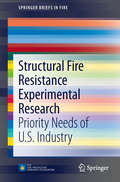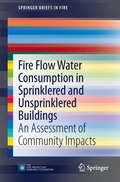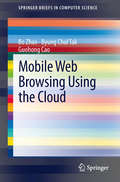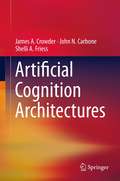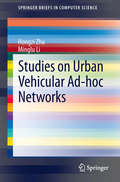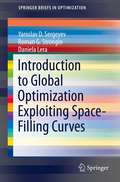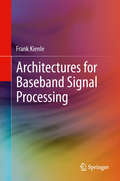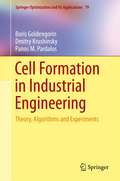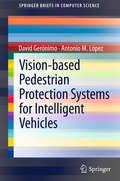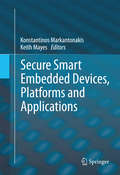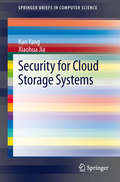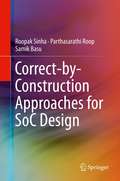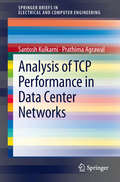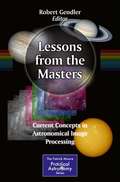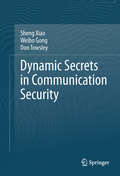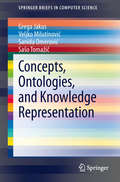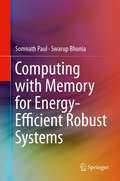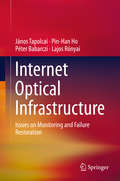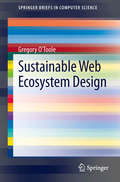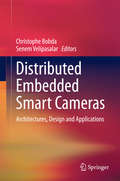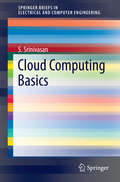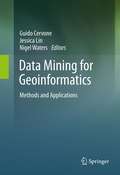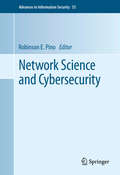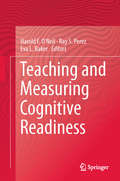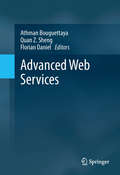- Table View
- List View
Structural Fire Resistance Experimental Research: Priority Needs of U.S. Industry
by Kathleen H AlmandStructural Fire Resistance Experimental Research - Priority Needs of U.S. Industry provides a synthesis of stakeholder input to a prioritized agenda for research at the National Fire Research Laboratory (NFRL) at the National Institute of Standards and Technology (NIST) designed to accelerate the implementation of performance-based fire engineering for structures. The NFRL presents a broad range of unanswered questions regarding the performance of real structures in fire conditions, and informs performance-based design methods and standards in this field. The authors conducted a comprehensive literature review of large-scale structural fire testing and compiled research needs from a variety of sources. The book addresses major issues of broad concern in the fire community, such as real fire exposure and structural response, composite floor system performance, enhancing modeling performance, and understanding the embedded safety features in design methods. It concludes with a prioritized set of research recommendations for the NIST facility. The scope of issues addressed and broad range of content make this a valuable book for researchers in all aspects of fire resistance experimentation. It will also be useful for those who work with engineering standards for structures.
Fire Flow Water Consumption in Sprinklered and Unsprinklered Buildings: An Assessment of Community Impacts
by Inc. Code ConsultantsFire Flow Water Consumption in Sprinklered and Unsprinklered Buildings offers a detailed analysis for calculating the fire water demand required in buildings with existing and non-existant sprinkler systems. The installation of automatic sprinkler systems can significantly reduce the amount of water needed during a fire, but it requires water for commissioning, inspection, testing, and maintenance (CITM). This book provides an estimate of fire water used under both fire conditions, including CITM, to allow communities to develop fire water fees for both sprinklered and unsprinklered buildings that are proportional to the anticipated fire water usage. The types of buildings analyzed include residential (family dwellings as well as those up to four stories in height), business, assembly, institutional, mercantile, and storage facilities. Water volume was studied using guidelines from the International Code Council, the National Fire Protection Association, and the Insurance Services Office. Fire Flow Water Consumption in Sprinklered and Unsprinklered Buildings is intended for practitioners as a tool for analyzing water consumption in fire situations and for providing them with key information on the best types of water systems in a variety of buildings. Researchers working in building planning and safety will also find the book valuable.
Mobile Web Browsing Using the Cloud
by Byung Chul Tak Guohong Cao Bo ZhaoThis brief surveys existing techniques to address the problem of long delays and high power consumption for web browsing on smartphones, which can be due to the local computational limitation at the smartphone (e.g., running java scripts or flash objects) level. To address this issue, an architecture called Virtual-Machine based Proxy (VMP) is introduced, shifting the computing from smartphones to the VMP which may reside in the cloud. Mobile Web Browsing Using the Cloud illustrates the feasibility of deploying the proposed VMP system in 3G networks through a prototype using Xen virtual machines (in cloud) and Android Phones with ATT UMTS network. Techniques to address scalability issues, resource management techniques to optimize the performance of the VMs on the proxy side, compression techniques to further reduce the bandwidth consumption, and adaptation techniques to address poor network conditions on the smartphone are also included.
Artificial Cognition Architectures
by Shelli Friess John N. Carbone James CrowderThe goal of this book is to establish the foundation, principles, theory, and concepts that are the backbone of real, autonomous Artificial Intelligence. Presented here are some basic human intelligence concepts framed for Artificial Intelligence systems. These include concepts like Metacognition and Metamemory, along with architectural constructs for Artificial Intelligence versions of human brain functions like the prefrontal cortex. Also presented are possible hardware and software architectures that lend themselves to learning, reasoning, and self-evolution
Studies on Urban Vehicular Ad-hoc Networks
by Minglu Li Hongzi ZhuWith the advancement of wireless technology, vehicular ad hoc networks (VANETs) are emerging as a promising approach to realizing "smart cities" and addressing many important transportation problems such as road safety, efficiency, and convenience. This brief provides an introduction to the large trace data set collected from thousands of taxis and buses in Shanghai, the largest metropolis in China. It also presents the challenges, design issues, performance modeling and evaluation of a wide spectrum of VANET research topics, ranging from realistic vehicular mobility models and opportunistic routing, to real-time vehicle tracking and urban sensing applications. In addition to the latest research and techniques, the reader will also learn the trace-driven methodologies and tools of performance modeling and analysis, network protocol design and optimization, and network simulation, thus keeping pace with the fast moving VANET research and development.
Introduction to Global Optimization Exploiting Space-Filling Curves
by Yaroslav D. Sergeyev Daniela Lera Roman G. StronginIntroduction to Global Optimization Exploiting Space-Filling Curves provides an overview of classical and new results pertaining to the usage of space-filling curves in global optimization. The authors look at a family of derivative-free numerical algorithms applying space-filling curves to reduce the dimensionality of the global optimization problem; along with a number of unconventional ideas, such as adaptive strategies for estimating Lipschitz constant, balancing global and local information to accelerate the search. Convergence conditions of the described algorithms are studied in depth and theoretical considerations are illustrated through numerical examples. This work also contains a code for implementing space-filling curves that can be used for constructing new global optimization algorithms. Basic ideas from this text can be applied to a number of problems including problems with multiextremal and partially defined constraints and non-redundant parallel computations can be organized. Professors, students, researchers, engineers, and other professionals in the fields of pure mathematics, nonlinear sciences studying fractals, operations research, management science, industrial and applied mathematics, computer science, engineering, economics, and the environmental sciences will find this title useful .
Architectures for Baseband Signal Processing
by Frank KienleThis book addresses challenges faced by both the algorithm designer and the chip designer, who need to deal with the ongoing increase of algorithmic complexity and required data throughput for today's mobile applications. The focus is on implementation aspects and implementation constraints of individual components that are needed in transceivers for current standards, such as UMTS, LTE, WiMAX and DVB-S2. The application domain is the so called outer receiver, which comprises the channel coding, interleaving stages, modulator, and multiple antenna transmission. Throughout the book, the focus is on advanced algorithms that are actually in use in modern communications systems. Their basic principles are always derived with a focus on the resulting communications and implementation performance. As a result, this book serves as a valuable reference for two, typically disparate audiences in communication systems and hardware design.
Cell Formation in Industrial Engineering: Theory, Algorithms and Experiments (Springer Optimization and Its Applications #79)
by Panos M. Pardalos Boris Goldengorin Dmitry KrushinskyThis book focuses on a development of optimal, flexible, and efficient models and algorithms for cell formation in group technology. Its main aim is to provide a reliable tool that can be used by managers and engineers to design manufacturing cells based on their own preferences and constraints imposed by a particular manufacturing system. This tool could potentially lower production costs by minimizing other costs in a number of areas, thereby increasing profit in a manufacturing system. In the volume, the cell formation problem is considered in a systematic and formalized way, and several models are proposed, both heuristic and exact. The models are based on general clustering problems, and are flexible enough to allow for various objectives and constraints. The authors also provide results of numerical experiments involving both artificial data from academic papers in the field and real manufacturing data to certify the appropriateness of the models proposed. The book was intended to suit the broadest possible audience, and thus all algorithmic details are given in a detailed description with multiple numerical examples and informal explanations are provided for the theoretical results. In addition to managers and industrial engineers, this book is intended for academic researchers and students. It will also be attractive to many theoreticians, since it addresses many open problems in computer science and bioinformatics.
Vision-based Pedestrian Protection Systems for Intelligent Vehicles
by Antonio M. López David GerónimoPedestrian Protection Systems (PPSs) are on-board systems aimed at detecting and tracking people in the surroundings of a vehicle in order to avoid potentially dangerous situations. These systems, together with other Advanced Driver Assistance Systems (ADAS) such as lane departure warning or adaptive cruise control, are one of the most promising ways to improve traffic safety. By the use of computer vision, cameras working either in the visible or infra-red spectra have been demonstrated as a reliable sensor to perform this task. Nevertheless, the variability of human's appearance, not only in terms of clothing and sizes but also as a result of their dynamic shape, makes pedestrians one of the most complex classes even for computer vision. Moreover, the unstructured changing and unpredictable environment in which such on-board systems must work makes detection a difficult task to be carried out with the demanded robustness. In this brief, the state of the art in PPSs is introduced through the review of the most relevant papers of the last decade. A common computational architecture is presented as a framework to organize each method according to its main contribution. More than 300 papers are referenced, most of them addressing pedestrian detection and others corresponding to the descriptors (features), pedestrian models, and learning machines used. In addition, an overview of topics such as real-time aspects, systems benchmarking and future challenges of this research area are presented.
Secure Smart Embedded Devices, Platforms and Applications
by Konstantinos Markantonakis Keith MayesNew generations of IT users are increasingly abstracted from the underlying devices and platforms that provide and safeguard their services. As a result they may have little awareness that they are critically dependent on the embedded security devices that are becoming pervasive in daily modern life. Secure Smart Embedded Devices, Platforms and Applications provides a broad overview of the many security and practical issues of embedded devices, tokens, and their operation systems, platforms and main applications. It also addresses a diverse range of industry/government initiatives and considerations, while focusing strongly on technical and practical security issues. The benefits and pitfalls of developing and deploying applications that rely on embedded systems and their security functionality are presented. A sufficient level of technical detail to support embedded systems is provided throughout the text, although the book is quite readable for those seeking awareness through an initial overview of the topics. This edited volume benefits from the contributions of industry and academic experts and helps provide a cross-discipline overview of the security and practical issues for embedded systems, tokens, and platforms. It is an ideal complement to the earlier work, Smart Cards Tokens, Security and Applications from the same editors.
Security for Cloud Storage Systems
by Xiaohua Jia Kan YangCloud storage is an important service of cloud computing, which offers service for data owners to host their data in the cloud. This new paradigm of data hosting and data access services introduces two major security concerns. The first is the protection of data integrity. Data owners may not fully trust the cloud server and worry that data stored in the cloud could be corrupted or even removed. The second is data access control. Data owners may worry that some dishonest servers provide data access to users that are not permitted for profit gain and thus they can no longer rely on the servers for access control. To protect the data integrity in the cloud, an efficient and secure dynamic auditing protocol is introduced, which can support dynamic auditing and batch auditing. To ensure the data security in the cloud, two efficient and secure data access control schemes are introduced in this brief: ABAC for Single-authority Systems and DAC-MACS for Multi-authority Systems. While Ciphertext-Policy Attribute-based Encryption (CP-ABE) is a promising technique for access control of encrypted data, the existing schemes cannot be directly applied to data access control for cloud storage systems because of the attribute revocation problem. To solve the attribute revocation problem, new Revocable CP-ABE methods are proposed in both ABAC and DAC-MACS.
Correct-by-Construction System on Chip Design
by Parthasarathi Roop Samik Basu Roopak SinhaThis book describes an approach for designing Systems-on-Chip such that the system meets precise mathematical requirements. The methodologies presented enable embedded systems designers to reuse intellectual property (IP) blocks from existing designs in an efficient, reliable manner, automatically generating correct SoCs from multiple, possibly mismatching, components.
Analysis of TCP Performance in Data Center Networks (SpringerBriefs in Electrical and Computer Engineering)
by Santosh Kulkarni Prathima AgrawalThis book addresses the need to improve TCP's performance inside data centers by providing solutions that are both practical and backward compatible with standard TCP versions. The authors approach this challenge first by deriving an analytical model for TCP's performance under typical data center workload traffic. They then discuss some solutions that are designed to improve TCP performance by either proactively detecting network congestion through probabilistic retransmission or by avoiding timeout penalty through dynamic resizing of TCP segments. Experimental results show that each of techniques discussed outperforms standard TCP inside a data center.
Lessons from the Masters: Current Concepts in Astronomical Image Processing
by Robert GendlerThere are currently thousands of amateur astronomers around the world engaged in astrophotography at a sophisticated level. Their ranks far outnumber professional astronomers doing the same and their contributions both technically and artistically are the dominant drivers of progress in the field today. This book is a unique collaboration of individuals world-renowned in their particular area and covers in detail each of the major sub-disciplines of astrophotography. This approach offers the reader the greatest opportunity to learn the most current information and the latest techniques directly from the foremost innovators in the field today. "Lessons from the Masters" includes a brilliant body of recognized leaders in astronomical imaging, assembled by Robert Gendler, who delivers the most current, sophisticated and useful information on digital enhancement techniques in astrophotography available today. Each chapter focuses on a particular technique, but the book as a whole covers all types of astronomical image processing, including processing of events such as eclipses, using DSLRs, and deep-sky, planetary, widefield, and high resolution astronomical image processing. Recognized contributors include deep-sky experts such as Jay GaBany, Tony Hallas, and Ken Crawford, high-resolution planetary expert Damian Peach, and the founder of TWAN (The World at Night) Babak A. Tafreshi. A large number of illustrations (150, 75 in color) present the challenges and accomplishments involved in the processing of astronomical images by enthusiasts.
Dynamic Secrets in Communication Security
by Don Towsley Sheng Xiao Weibo GongDynamic secrets are constantly generated and updated from messages exchanged between two communication users. When dynamic secrets are used as a complement to existing secure communication systems, a stolen key or password can be quickly and automatically reverted to its secret status without disrupting communication. "Dynamic Secrets in Communication Security" presents unique security properties and application studies for this technology. Password theft and key theft no longer pose serious security threats when parties frequently use dynamic secrets. This book also illustrates that a dynamic secret based security scheme guarantees impersonation attacks are detected even if an adversary steals a user's password or their key is lost. Practitioners and researchers working in network security or wireless communications will find this book a must-have reference. "Dynamic Secrets in Communication Security" is also a valuable secondary text for advanced-level students in computer science and electrical engineering.
Concepts, Ontologies, and Knowledge Representation (SpringerBriefs in Computer Science)
by Veljko Milutinović Sanida Omerovic Grega Jakus Saso TomazicRecording knowledge in a common framework that would make it possible to seamlessly share global knowledge remains an important challenge for researchers. This brief examines several ideas about the representation of knowledge addressing this challenge. A widespread general agreement is followed that states uniform knowledge representation should be achievable by using ontologies populated with concepts. A separate chapter is dedicated to each of the three introduced topics, following a uniform outline: definition, organization, and use. This brief is intended for those who want to get to know the field of knowledge representation quickly, or would like to be up to date with current developments in the field. It is also useful for those dealing with implementation as examples of numerous operational systems are also given.
Computing with Memory for Energy-Efficient Robust Systems
by Swarup Bhunia Somnath PaulThis book analyzes energy and reliability as major challenges faced by designers of computing frameworks in the nanometer technology regime. The authors describe the existing solutions to address these challenges and then reveal a new reconfigurable computing platform, which leverages high-density nanoscale memory for both data storage and computation to maximize the energy-efficiency and reliability. The energy and reliability benefits of this new paradigm are illustrated and the design challenges are discussed. Various hardware and software aspects of this exciting computing paradigm are described, particularly with respect to hardware-software co-designed frameworks, where the hardware unit can be reconfigured to mimic diverse application behavior. Finally, the energy-efficiency of the paradigm described is compared with other, well-known reconfigurable computing platforms.
Internet Optical Infrastructure
by János Tapolcai Pin-Han Ho Péter Babarczi Lajos RónyaiThis book covers the issues of monitoring, failure localization, and restoration in the Internet optical backbone, and focuses on the progress of state-of-the-art in both industry standard and academic research. The authors summarize, categorize, and analyze the developed technology in the context of Internet fault management and failure recovery under the Generalized Multi-Protocol Label Switching (GMPLS), via both aspects of network operations and theories.
Sustainable Web Ecosystem Design
by Gregory O'TooleThis book is about the process of creating web-based systems (i.e., websites, content, etc.) that consider each of the parts, the modules, the organisms - binary or otherwise - that make up a balanced, sustainable web ecosystem. In the current media-rich environment, a website is more than a collection of relative html documents of text and images on a static desktop computer monitor. There is now an unlimited combination of screens, devices, platforms, browsers, locations, versions, users, and exabytes of data with which to interact. Written in a highly approachable, practical style, this book is useful for stakeholders, system administrators, developers, designers, content managers, and the anonymous web user in industry, as well as faculty, staff, and students of all levels involved in teaching and learning in information technology.
Distributed Embedded Smart Cameras
by Christophe Bobda Senem VelipasalarThis publication addresses distributed embedded smart cameras -cameras that perform on board analysis and collaborate with other cameras. This book provides the material required to better understand the architectural design challenges of embedded smart camera systems, the hardware/software ecosystem, the design approach for and applications of distributed smart cameras together with the state-of-the-art algorithms. The authors concentrate on the architecture, hardware/software design, realization of smart camera networks from applications to architectures, in particular in the embedded and mobile domains.
Cloud Computing Basics (SpringerBriefs in Electrical and Computer Engineering)
by S. SrinivasanCloud Computing Basics covers the main aspects of this fast moving technology so that both practitioners and students will be able to understand cloud computing. The author highlights the key aspects of this technology that a potential user might want to investigate before deciding to adopt this service. This book explains how cloud services can be used to augment existing services such as storage, backup and recovery. Addressing the details on how cloud security works and what the users must be prepared for when they move their data to the cloud. Also this book discusses how businesses could prepare for compliance with the laws as well as industry standards such as the Payment Card Industry.
Data Mining for Geoinformatics: Methods and Applications
by Jessica Lin Guido Cervone Nigel WatersThe rate at which geospatial data is being generated exceeds our computational capabilities to extract patterns for the understanding of a dynamically changing world. Geoinformatics and data mining focuses on the development and implementation of computational algorithms to solve these problems. This unique volume contains a collection of chapters on state-of-the-art data mining techniques applied to geoinformatic problems of high complexity and important societal value. Data Mining for Geoinformatics addresses current concerns and developments relating to spatio-temporal data mining issues in remotely-sensed data, problems in meteorological data such as tornado formation, estimation of radiation from the Fukushima nuclear power plant, simulations of traffic data using OpenStreetMap, real time traffic applications of data stream mining, visual analytics of traffic and weather data and the exploratory visualization of collective, mobile objects such as the flocking behavior of wild chickens. This book is designed for researchers and advanced-level students focused on computer science, earth science and geography as a reference or secondary text book. Practitioners working in the areas of data mining and geoscience will also find this book to be a valuable reference.
Network Science and Cybersecurity
by Robinson E. PinoNetwork Science and Cybersecurity introduces new research and development efforts for cybersecurity solutions and applications taking place within various U.S. Government Departments of Defense, industry and academic laboratories. This book examines new algorithms and tools, technology platforms and reconfigurable technologies for cybersecurity systems. Anomaly-based intrusion detection systems (IDS) are explored as a key component of any general network intrusion detection service, complementing signature-based IDS components by attempting to identify novel attacks. These attacks may not yet be known or have well-developed signatures. Methods are also suggested to simplify the construction of metrics in such a manner that they retain their ability to effectively cluster data, while simultaneously easing human interpretation of outliers. This is a professional book for practitioners or government employees working in cybersecurity, and can also be used as a reference. Advanced-level students in computer science or electrical engineering studying security will also find this book useful .
Teaching and Measuring Cognitive Readiness
by Eva L Baker Ray S. Perez Harold F. O'NeilTeaching and Measuring Cognitive Readiness presents theoretical and empirical findings regarding cognitive readiness and assessments of their impact on adult learning. The term readiness is used in assessing student preparation for K-12 schools, while in the military and in industry, "readiness" denotes preparation to be effective in performing a mission or a job. Cognitive Readiness is viewed through a Knowledge, Skills, and Attributes (KSA) lens. Teaching and Measuring Cognitive Readiness deals with (a) the primacy of cognitive readiness as attributes or individual difference variables; (b) the need for cognitive readiness instructional and assessment strategies; (c) the need to integrate assessment into cognitive readiness training; (d) the need for theory-driven evaluation studies to increase knowledge and efficacy in teaching cognitive readiness; and (e) the need for a solid psychometric approach to the use of cognitive readiness assessments.
Advanced Web Services (Advances In Database Systems Ser.)
by Quan Z. Sheng Athman Bouguettaya Florian DanielWeb services and Service-Oriented Computing (SOC) have become thriving areas of academic research, joint university/industry research projects, and novel IT products on the market. SOC is the computing paradigm that uses Web services as building blocks for the engineering of composite, distributed applications out of the reusable application logic encapsulated by Web services. Web services could be considered the best-known and most standardized technology in use today for distributed computing over the Internet. This book is the second installment of a two-book collection covering the state-of-the-art of both theoretical and practical aspects of Web services and SOC research and deployments. Advanced Web Services specifically focuses on advanced topics of Web services and SOC and covers topics including Web services transactions, security and trust, Web service management, real-world case studies, and novel perspectives and future directions. The editors present foundational topics in the first book of the collection, Web Services Foundations (Springer, 2013). Together, both books comprise approximately 1400 pages and are the result of an enormous community effort that involved more than 100 authors, comprising the world's leading experts in this field.
